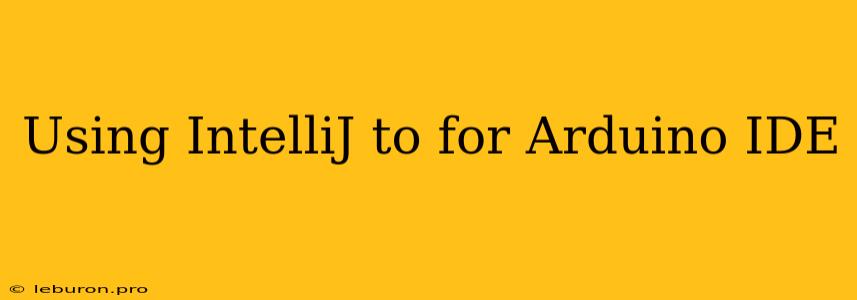Unlocking Efficiency: Using IntelliJ IDEA for Arduino Development
The Arduino platform is a beloved choice for hobbyists and professionals alike, offering a user-friendly environment for prototyping and building embedded systems. While the Arduino IDE provides a basic interface for writing and uploading code, there are situations where a more powerful and feature-rich development environment can be beneficial. Enter IntelliJ IDEA, a widely recognized and robust IDE for Java development, which can be seamlessly integrated with the Arduino ecosystem to enhance your coding experience. This article will explore how to leverage IntelliJ IDEA's capabilities to streamline your Arduino development workflow.
Setting up IntelliJ IDEA for Arduino Development
Before diving into the benefits of using IntelliJ IDEA, it's crucial to establish a functional setup. Here's a step-by-step guide to configuring IntelliJ IDEA for Arduino development:
- Installing IntelliJ IDEA: If you don't have IntelliJ IDEA already, download and install the Community Edition from the official website. The Community Edition is free and offers a comprehensive suite of features suitable for Arduino development.
- Installing the Arduino Plugin: The Arduino plugin for IntelliJ IDEA is essential to bridge the gap between the IDE and the Arduino environment. You can install this plugin directly from IntelliJ IDEA's marketplace. Go to File > Settings > Plugins and search for "Arduino."
- Configuring the Arduino Plugin: Once installed, configure the plugin by specifying the location of your Arduino IDE installation, the board type you'll be using (e.g., Arduino Uno), and the serial port connected to your Arduino board.
- Creating a New Arduino Project: In IntelliJ IDEA, navigate to File > New > Project and choose "Arduino" from the available project types. Provide a project name and the path to your project directory.
Unveiling the Advantages of IntelliJ IDEA for Arduino
Now that you have a functioning setup, let's delve into the key advantages that IntelliJ IDEA brings to the table for Arduino development:
1. Code Completion and Syntax Highlighting:
IntelliJ IDEA boasts powerful code completion features that can significantly speed up your coding process. As you type, IntelliJ IDEA will suggest relevant variables, functions, and keywords, reducing typos and enhancing efficiency. Additionally, syntax highlighting helps visually identify different code elements (e.g., keywords, variables, comments) for easier readability and comprehension.
2. Advanced Refactoring:
When working with larger Arduino projects, refactoring becomes essential for code organization and maintainability. IntelliJ IDEA provides a range of refactoring tools, including renaming variables, extracting methods, and moving code blocks, making code modifications safe and efficient.
3. Debugging Capabilities:
IntelliJ IDEA comes equipped with a robust debugger, allowing you to step through your code line by line, inspect variables, and identify issues within your program. This debugging capability is invaluable for tracking down and fixing bugs, especially in complex Arduino projects.
4. Integrated Version Control:
Version control systems like Git are essential for managing code changes over time. IntelliJ IDEA seamlessly integrates with popular version control systems, enabling you to commit code, track changes, and collaborate with other developers.
5. Customizable Environment:
IntelliJ IDEA provides a highly customizable development environment tailored to your preferences. You can adjust themes, font sizes, key bindings, and other settings to create a workspace that suits your workflow.
Streamlining Your Arduino Development Workflow
IntelliJ IDEA's features can greatly simplify your Arduino development workflow, fostering a more efficient and productive development process. Here are a few key areas where IntelliJ IDEA excels:
- Code Organization: With features like code completion and syntax highlighting, IntelliJ IDEA helps you write cleaner and more organized Arduino code.
- Error Detection and Resolution: The IDE's advanced code analysis and debugging tools enable you to quickly identify and fix errors, saving you valuable time and effort.
- Code Management: Version control integration simplifies collaboration and ensures seamless tracking of code changes.
- Focus on Functionality: By offloading tasks like code completion, refactoring, and debugging to IntelliJ IDEA, you can focus on the core logic of your Arduino projects.
Conclusion
Utilizing IntelliJ IDEA for Arduino development opens up a world of possibilities, empowering you with powerful tools to streamline your coding process and elevate your Arduino projects to new heights. While the Arduino IDE provides a comfortable entry point, IntelliJ IDEA offers an advanced environment for more complex and ambitious projects. By leveraging its features, you can enhance your code quality, reduce development time, and ultimately create more robust and innovative embedded solutions using the Arduino platform. Remember, the key to effective development lies in choosing the right tools for the job, and IntelliJ IDEA is a potent ally for serious Arduino developers.
